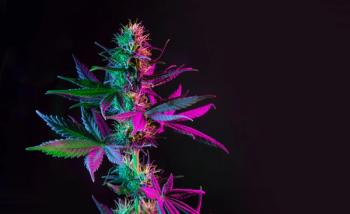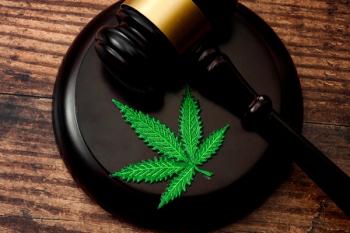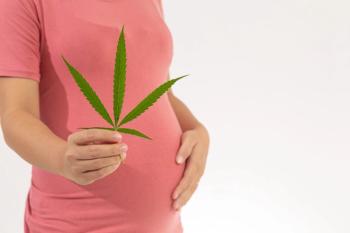"As the use of CBD-containing products continues to rise, it is imperative pharmacists be familiar with the clinical implications of CBD’s use, especially in patients who use other pharmacologically active substances."
- Drug Topics November 2020
- Volume 165
- Issue 11
Cannabidiol (CBD) 101: Overview and Potential Interactions
As the use of CBD-containing products continues to rise, pharmacists need to be familiar with the clinical implications of CBD use, especially in patients who use other pharmacologically active substances.
During the past several years, the US market has seen an explosion in the popularity of cannabidiol (CBD)-containing products. These products are readily available to consumers through various retailers. Additionally, Epidiolex, a natural form of CBD, is available as a prescription drug for the treatment of seizures associated with Lennox-Gastaut syndrome, Dravet syndrome, or tuberous sclerosis complex in patients aged 1 year and older.1 Under US federal law, cannabis-derived products with very low levels of Δ-9-tetrahydrocannabinol (THC; < 0.3%) are considered “industrial hemp”.2 Per the Agriculture Improvement Act of 2018 (the 2018 Farm Act), cannabis plants and derivatives that contain no more than 0.3 % THC are not considered controlled substances.3 It is important to note that CBD-containing products currently are not classified by the FDA as dietary supplements.3
As the use of CBD-containing products continues to rise, it is imperative pharmacists be familiar with the clinical implications of CBD’s use, especially in patients who use other pharmacologically active substances.
Pharmacology
The cannabis plant possesses many compounds, including cannabinoids, terpenoids, flavonoids, nitrogenous compounds, and other molecules.2 Three major cannabinoids are Δ-9-THC (the psychoactive component associated with the intoxicating effects of cannabis and primarily involved in its recreational use), cannabinol (CBN), and CBD. The pharmacology of CBD is not fully understood. Studies suggest that its effects are related to its interaction with the endocannabinoid system.4 Some of its effects, however, are attributed to other mechanisms; for example, its anticonvulsant activities may involve a number of mechanisms, including blockade of G protein-coupled receptor 55 (GPR55) and T-type voltage-gated calcium channels, as well as stimulation of 5-HT1a and 5-HT2a receptors.5
Clinical Use
CBD-containing products are marketed as remedies for various conditions, such as joint pain, back pain, insomnia, stress, depression, inflammation, mood elevation, immunity enhancement, improved brain activity, maintenance of hormonal balance, and indigestion.6 Many, if not most, of these claims have not been substantiated. In contrast, there are conditions for which limited evidence does exist that CBD may be of benefit. Examples include psychosis and schizophrenia, substance use disorders, seizure disorders, Parkinson disease and spasticity, and anxiety disorders.4,7,8 It is important to recognize that much of the clinical evidence for the use of CBD stems from case reports and/or from a small number of studies that often carry significant limitations. Moreover, the clinical implications of effects identified in case reports and studies cannot always be ascertained. Likewise, the source of CBD (eg, synthetic or plant extract) used in these case reports and studies is not always specified. All these limitations preclude drawing firm conclusions on the benefits of CBD in the clinical management of these conditions in the general population.
Adverse Effects
Based on clinical trials data described in Epidiolex’s prescribing information, the most common adverse effects (occurring in at least 10% of patients treated with Epidiolex and to a greater extent than with placebo) in patients with Lennox-Gastaut syndrome or Dravet syndrome are somnolence, decreased appetite, diarrhea, transaminase elevations, fatigue, malaise, asthenia, rash, insomnia, sleep disorder, and infections.1 The most common adverse effects in patients with tuberous sclerosis complex are diarrhea, transaminase elevations, decreased appetite, somnolence, pyrexia, and vomiting.1
Pharmacokinetics
CBD has an estimated oral bioavailability of 6% and is highly lipophilic, readily crossing the blood-brain barrier.5 High-fat/high-calorie meals significantly increase the maximum concentration and the area under the curve.4 CBD has a large volume of distribution and is greater than 94% protein bound.5 At steady state, the time to peak plasma concentration occurs between 2.5 and 5 hours.5 CBD is primarily metabolized in the liver (and to some extent in the gut) through cytochromes P450 (CYP2C19 and CYP3A) and uridine 5′-diphospho-glucuronosyltransferase (UGT1A7, UGT1A9, and UGT2B7 isoforms).4 CBD has 1 active metabolite, 7-OH-CBD, which is metabolized to the inactive metabolite, 7-COOH-CBD.4 CBD is almost exclusively excreted in the feces and has an elimination half-life of 56 to 61 hours.5
Drug Interactions
CBD’s pharmacokinetic and pharmacologic properties have implications on its potential to interact with other pharmacologically active substances. Much of what is known about these potential interactions comes from data available for the prescription drug Epidiolex.1
Based on in vitro data, pharmacokinetic interactions are predicted with:
- CYP1A2 substrates (eg, theophylline, caffeine),
- CYP2B6 substrates (eg, bupropion, efavirenz),
- CYP2C8 and CYP2C9 (eg, phenytoin) substrates,
- Uridine 5'-diphospho-glucuronosyltransferase 1A9 (UGT1A9) substrates (eg, diflunisal, propofol, fenofibrate), and
- UGT2B7 substrates (eg, gemfibrozil, lamotrigine, morphine, lorazepam).
Additionally, in vivo data show that coadministration of CBD increases plasma concentrations of CYP2C19 substrates (eg, clobazam, diazepam) or their metabolites, and thus may increase the risk of adverse effects from these agents. Conversely, concurrent use with a strong CYP3A4 and CYP2C19 inducer (eg, rifampin) will result in a substantial decrease in CBD’s plasma concentration. As such, an increase in CBD’s dose should be considered when a strong inducer of CYP3A4 and/or CYP2C19 is coadministered.1
Concomitant use of CBD and valproate has resulted in liver enzyme elevations. Reports in the literature also suggest that cannabidiol administration resulted in increased serum levels of everolimus, sirolimus, or tacrolimus; the mechanism of this interaction is not clear. Likewise, concomitant use of CBD with other CNS depressants may increase the risk of sedation and somnolence.1
Much of the data concerning the potential interactions between CBD and other pharmacologically active agents is derived from studies and observations involving Epidiolex, a standardized form of CBD subject to strict FDA regulations and requirements. It is important to note, though, that CBD-containing products that are readily available to the consumer may not be subjected to the same rigorous quality assurance measures (eg, standards for growth, production, testing/analysis). Such issues have been identified in the past and found to result in variable amounts of CBD among marketed CBD-containing products.9 There are limited data on the bioavailability of CBD following oral administration of various CBD-containing dosage forms. This limits the ability to predict CBD’s pharmacokinetic parameters (ie, absorption, distribution, metabolism, excretion) as well as its pharmacologic and clinical effects, including its potential to interact with other agents.10
Pharmacists and other health care professionals must be aware that these issues may affect exposure to CBD and affect concurrent pharmacologically active therapies. Pharmacists must carefully monitor drug therapy in patients using any form of CBD. While the clinical significance of the potential interactions between CBD and other agents is not certain, it is important for pharmacists to be mindful of them and recommend appropriate courses of action.
REFERENCES:
- Epidiolex (cannabidiol). Package insert. Greenwich Biosciences, Inc. Updated June 2018. Accessed October 16, 2020. https://www.accessdata.fda.gov/drugsatfda_docs/label/2018/210365lbl.pdf
- The National Academies of Sciences, Engineering, and Medicine. The Health Effects of Cannabis and Cannabinoids: The Current State of Evidence and Recommendations for Research. The National Academies Press. 2017.
- FDA. FDA Regulation of Cannabis and Cannabis-Derived Products, Including Cannabidiol (CBD). Updated October 1, 2020. Accessed October 16, 2020. https://www.fda.gov/news-events/public-health-focus/fda-regulation-cannabis-and-cannabis-derived-products-including-cannabidiol-cbd#legaltosell
- White CM. A review of human studies assessing cannabidiol’s (CBD) therapeutic actions and potential. J Clin Pharmacol. 2019;59(7):923-934. doi:10.1002/jcph.1387
- Chen JW, Borgelt LM, Blackmer AB. Cannabidiol: A new hope for patients with Dravet or Lennox-Gastaut syndromes. Ann Pharmacother. 2019;53(6):603-611.
- CBD oil. Amazon.com. Accessed October 15, 2020.
https://www.amazon.com/s?k=cbd+oil&ref=nb_sb_noss_2 - Batalla A, Janssen H, Gangadin SS, Bossong MG. The potential of cannabidiol as treatment for psychosis and addiction: who benefits most? A systematic review. J Clin Med. 2019;8(7):1058. doi:10.3390/jcm8071058
- Millar SA, Stone NL, Bellman ZD, Yates AS, England TJ, O’Sullivan SE. A systematic review of cannabidiol dosing in clinical populations. Br J Clin Pharmacol. 2019;85(9):1888-1900. doi:10.1111/bcp.14038
- Bonn-Miller MO, Loflin MJE, Thomas BF, Marcu JP, Hyke T, Vandrey R. Labeling accuracy of cannabidiol extracts sold online. JAMA. 2017;318(17):1708-1709. doi:10.1001/jama.2017.11909
- Walker LA, Koturbash I, Kingston R, et al. Cannabidiol (CBD) in dietary supplements: perspectives on science, safety, and potential regulatory approaches. J Diet Suppl. 2020;17(5):493-502. doi:10.1080/19390211.2020.1777244
Articles in this issue
about 5 years ago
CBD: A Look at the Legal Landscapeabout 5 years ago
Inpatient Pharmacy-Based Pain Management Service Improves Outcomesabout 5 years ago
Cancer Care In Transitionabout 5 years ago
Boosting Business With CBDabout 5 years ago
Use This Checklist To Select Your CBD Productabout 5 years ago
Educate Patients About Affordable, Accessible Insulin Optionsabout 5 years ago
Improving Pharmacist-Physician Collaborationabout 5 years ago
How Pharmacists Can Make the Most of Their Technician's SkillsNewsletter
Pharmacy practice is always changing. Stay ahead of the curve with the Drug Topics newsletter and get the latest drug information, industry trends, and patient care tips.




































































































































